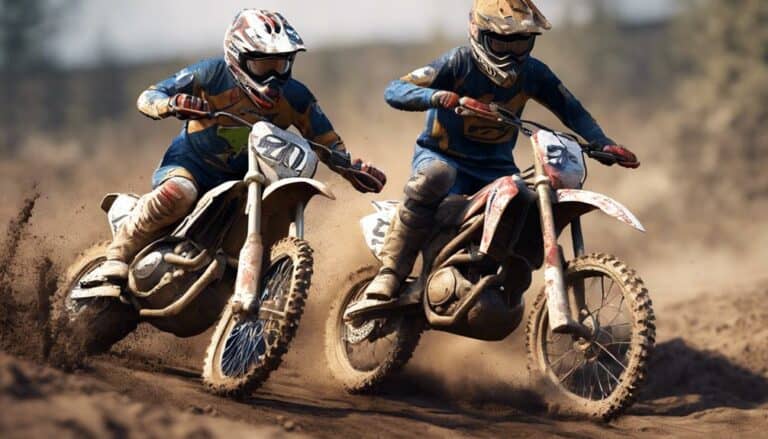When riding corners on a dirt bike, the terrain you encounter plays an essential role in determining your approach. From gravel to mud to hard-packed dirt, each surface demands specific adjustments in your cornering techniques. The way you lean into a turn and modulate your throttle can mean the difference between a smooth exit or a loss of control.
But what about those tricky off-camber corners or deceptive sand traps? Stay tuned to uncover how mastering these variations can elevate your dirt biking prowess to the next level.
Key Takeaways
- Rutted corners demand release of rear brake for control and momentum, focusing on stability and utilizing leg positioning.
- Flat corners require outside footpeg weight distribution, precise throttle management, and correct body alignment for smooth negotiation.
- Sand turns necessitate standing on footpegs, centering weight distribution, controlled deceleration, and smooth line selection for traction.
- Impact of hard packed terrain allows aggressive lean angles, precise throttle control, and smoother racing lines with minimized skidding risk.
Rutted Corners Cornering Techniques
When negotiating rutted corners on a dirt bike, releasing the rear brake before entry is essential for maintaining momentum and control. Rutted corners present a unique challenge due to the unpredictable nature of the terrain. To navigate these corners effectively, focus on stability and traction. Utilize leg and foot positioning to stabilize yourself and the bike as you approach the rut. Lean the bike into the rut to gain added support and traction, allowing you to maintain control through the corner.
Coordinating your body lean with the bike lean is vital for precise control in rutted corners. By leaning your body in the direction of the turn while also leaning the bike, you can optimize your weight distribution and grip on the terrain. Applying outside pressure on the outside peg further enhances stability and traction in rutted corners, helping you navigate through them with confidence.
Flat Corners Cornering Strategies
To navigate flat corners effectively on a dirt bike, mastering the art of initiating the turn from the outside and leaning the bike while keeping your body upright is important for best cornering performance. When tackling flat corners, consider the following strategies:
- Weight Distribution: Positioning your weight on the outside footpeg helps maintain balance and control, allowing you to lean the bike efficiently without losing stability.
- Throttle Management: Controlling the throttle is crucial in flat corners to manage traction and make a smooth exit. Adjusting your throttle input based on the terrain and track conditions can make a significant difference in your cornering performance.
- Body Positioning: Keeping your body upright and your head up during the turn not only aids in maintaining focus but also helps in negotiating flat corners smoothly. By aligning your body correctly with the bike, you can optimize your cornering capabilities on a dirt bike.
Sand Turns Cornering Tips
In handling sand turns on a dirt bike, prioritizing smooth line selection is essential for maintaining traction and control through the corner. When navigating sandy terrain, standing up on the footpegs helps distribute weight evenly, enhancing stability and preventing the bike from sinking in soft sand corners. Centering your weight on the bike is crucial to avoid getting stuck. To execute smooth sand turns, engage the clutch and rear brake simultaneously for controlled deceleration and cornering. Remember to maintain momentum by upshifting before entering the sand turn to prevent the bike from bogging down. By implementing these techniques, you can confidently conquer sand turns with precision and agility.
| Sand Turns Cornering Tips | |
|---|---|
| Stand Up on Footpegs | Distributes Weight |
| Center Weight Distribution | Prevents Sinking |
| Utilize Clutch and Rear Brake | Controlled Deceleration |
| Smooth Line Selection | Maintains Traction |
Impact of Hard Packed Terrain on Cornering
On hard packed terrain, the increased traction and stability greatly impact cornering dynamics for dirt bike riders. This type of surface offers a solid foundation for executing precise cornering techniques and achieving higher speeds through turns.
Here are three key points to take into account:
- Essential Stability: The firm nature of hard packed terrain allows riders to lean their bikes at more aggressive angles without the fear of losing traction. This stability enables you to push the limits of your lean angles and maintain control throughout the corner.
- Peak Acceleration: With the improved traction provided by hard packed surfaces, mastering throttle control becomes essential. Precise manipulation of the throttle allows you to accelerate efficiently out of corners, utilizing the available grip to its fullest potential.
- Important Reduced Skidding: Compared to looser surfaces, hard packed terrain minimizes the risk of skidding while cornering. This allows you to focus on maintaining a smooth racing line, avoiding unnecessary slides that can compromise your speed and control.
Track Conditions and Cornering Performance
Handling various track conditions demands different skill sets to optimize cornering performance and maintain control throughout the race.
When riding on deep sand tracks, it's important to keep your body position balanced and weight the outside footpeg to prevent the front wheel from washing out. Adjusting the compression damping on your fork springs can help absorb the undulations, allowing for smoother cornering in sandy terrain.
Additionally, in rocky tracks, focus on carefully selecting your line to avoid obstacles that could unsettle your bike's rear end. Maintaining the correct race sag and controlling your bike's movements through precise weight distribution can help you navigate through uneven or rutted tracks with confidence.
Conclusion
As you navigate the varied terrain and track conditions on your dirt bike, remember that each corner presents a unique challenge requiring precise technique and skill.
The key to mastering cornering lies in adapting to the specific demands of the environment, optimizing your approach, and maintaining control at all times.
Stay focused, anticipate the unexpected, and always be prepared to adjust your strategy on the fly.
The thrill of conquering corners awaits you, so ride on with confidence and finesse.

